| کد مقاله | کد نشریه | سال انتشار | مقاله انگلیسی | نسخه تمام متن |
|---|---|---|---|---|
| 2835441 | 1164342 | 2006 | 24 صفحه PDF | دانلود رایگان |

Hotspot archipelagoes provide exceptional models for the study of the evolutionary process, due to the effects of isolation and topographical diversity in inducing the formation of unique biotic assemblages. In this paper, we examine the evolutionary patterns exhibited by the jumping spider genus Havaika Prószyński, 2001 in the Polynesian islands of the Hawaiian and Marquesas chains. To date, systematic research on Havaika has been seriously limited by the poor taxonomic knowledge on the group, which was based on a handful of specimens that showed continuous variability and lacked clear-cut diagnostic characters. Here, we circumvent this problem by inferring a phylogeny based on DNA sequences of several fragments including both mitochondrial (protein coding cytochrome oxidase I, NAD1 dehydrogenase, ribosomal 16S, and tRNA leu) and nuclear (internal transcribed spacer 2) genes, and a statistical morphological analyses of a large sample of specimens. Results suggest that the Marquesan and Hawaiian Havaika may be the result of independent colonizations. Furthermore, data provide little support for the standard “progression rule” (evolution in the direction of older to younger islands) in Hawaiian Islands. This may be explained by a recent arrival of the group: age estimates of the different lineages suggest that Havaika colonized the Hawaiian Islands after most of the extant islands were already formed. The lack of clear-cut diagnostic characters among species may also be explained by the recent origin of the group since molecular data do not provide any evidence of hybridization among lineages. Quantitative morphological data coupled with the phylogenetic information allow us to reevaluate the current limitation of Havaika taxonomy. Molecular data support the existence of at least four different evolutionary lineages that are further morphologically diagnosable. However, genealogical relationships are better predicted by geographical affinity (i.e. island) than by morphological characters used in the original descriptions of the species. A pattern of size segregation linked to largely overlapping distributions of some of the species hints at a potential involvement of competition in generating morphological diversity. This study contributes to our understanding on the origin and shaping of the biodiversity of oceanic islands and sets the stage for more detailed studies on particular aspects of these previously overlooked spiders.
Journal: Molecular Phylogenetics and Evolution - Volume 41, Issue 2, November 2006, Pages 472–495